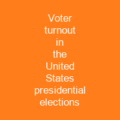Elections in the United States are held for government officials at the federal, state, and local levels. At the federal level, the nation’s head of state, the president, is elected indirectly by the people of each state. There are many elected offices at state level, each state having at least an elective governor and legislature. At local level, there are elected offices in counties, cities, towns, townships, boroughs, and villages. The eligibility of an individual for voting is set out in the constitution and also regulated at statelevel.
About Elections in the United States in brief

In 2016, Maine became the first state to adopt instant-runoff voting statewide for its elections, although due to state constitutional provisions, the system is only used for federal elections and state primaries. The Federal Elections Commission, created in 1975 by an amendment to the Federal Election Campaign Act, has the responsibility to disclose campaign finance information, to enforce the provisions of the law such as limits and prohibitions on contributions, and to oversee the public funding of U. S. presidential elections. The most common method used in U. s. elections is the first-past-the-post system, where the highest-polling candidate wins the election. Under this system, a candidate only requires a plurality of votes to win, rather than an outright majority. Some may use a two-round system,. where if no candidate receives a required number of votes then there is a runoff between the two candidates with the most votes. Voters rank the candidates in order of preference rather than voting for a single candidate. If a candidate secures more than half of votes cast, that candidate wins. Some states also have legacy constitutional statements barring those legally declared incompetent from voting; such references are generally considered obsolete and are being considered for review or removal where they appear. Some states ban convicted criminals, especially felons, from voting for indefinitely. In 2012, there were 519,682 elected officials in theUnited States as of 2012. While the federal has has decided over federal elections, most election laws are decided at the state level.
You want to know more about Elections in the United States?
This page is based on the article Elections in the United States published in Wikipedia (as of Dec. 05, 2020) and was automatically summarized using artificial intelligence.







